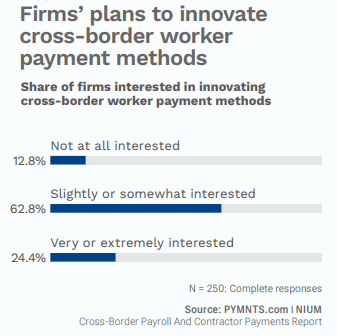Cross-Border Payments in Focus as Supply Chains Rebound From Pandemic

The signs are there that the supply chain snarls are unsnarling, just a bit.
But of course, things can change on a dime.
In the bid to better match supply and demand, the hard work lies ahead for enterprises large and small, with international reach.
Back-end frictions still exist in getting goods across borders, and paying for it all — which, after all, is what moves those goods, step by step, across the supply chains. Paying tax authorities, across a range of currencies? Well, that has its challenges too.
At first glance, commentary from the likes of Foxconn over the past few days gives the indication that as lockdowns in China are easing, per management’s commentary, the second half of 2022 is headed “in a better direction” than had been seen previously. The lingering impact of the war in Ukraine is a wild card, of course, and the pandemic is far from over.
But no matter how supply chains trend, the overarching themes remain intact: Digitization and modernization are critical in streamlining payments, which ultimately has a ripple effect on commerce.
We’re seeing pockets of innovation in cross-border payments to be sure — and evidence that more companies are becoming ever-more global in scope. In one recent report, 60% of companies surveyed by PYMNTS reported hiring more international workers. But they also report challenges in making payments and in satisfying tax requirements depending on where they do business.
Read also: The Data Point: 63% of Firms Want to Improve Cross-Border Payments for International Hires
Many of these companies want to improve cross border payments to those employees and contractors.

As these companies staff up new — or beef up existing — operations away from their home markets, we surmise that executives will at the same time want to improve supply chain visibility and flow.
That means partnering with providers to make sure that commercial payments can take into account how suppliers want to be paid, and when, which can improve the relationships between buyers and vendors. Myriad examples of the technology, and the software and APIs that facilitate all this abound, but by and large, embedded finance governs those new tech deployments.
Innovation and Modernization
In other PYMNTS research, as contained in the report “Meeting the Challenge of Payments Modernization: How Organizational Size Influences Innovation,” data show that nine out of 10 FIs are now pursuing or plan to pursue embedded finance solutions to ease B2B payments frictions. A significant percentage of FIs are intent on providing supplier portals, among other innovations, and in offering a range of payments choices.
In just one recent example spotlighted in this space, illuminating how new rails and automation can transform cross-border commerce, Omri Mor, CEO of B2B mass payout firm Routable, told PYMNTS CEO Karen Webster that faster payments, and in particular instant payments, “have a huge benefit in helping both parties resolve what they truly need, which is the transfer of money being complete.” That can be aided by direct to bank account RTP. Routable said earlier this month that it is partnering with the Real Time Payments network to offer its Real Time Payments services. The RTP services will enable those enterprises to securely pay vendors and contractors within seconds — directly between accounts.
Read more: B2B Payments to Woo Vendors, Try Offering Real-Time Payments
And, in addition, beyond individual company efforts, SWIFT, the global provider of financial messaging services, will conduct tests to link various central bank digital currency (CBDC) networks for cross-border transactions. The ongoing partnership with Capgemini will help SWIFT focus on specific use cases, including “CBDC to CBDC, fiat to CBDC, and CBDC to fiat.”
Also read: SWIFT to Test CBDC Ability to Facilitate Cross-Border Payments

